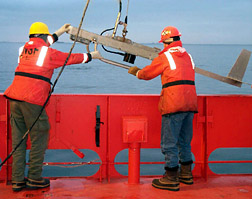King and Queen Neptune, at right, hold court aboard the Gould as it crossed the Antarctic Circle.

By Don Atwood
Special to the Sun
A t 66.5 degrees South latitude, along the Antarctic Peninsula, King and Queen Neptune were observed making a visitation aboard the USAP ice hardened vessel, Lawrence M Gould. They sat on the aft deck in regal finery and read a list of crimes to those who had never crossed the Antarctic Circle before. To do penance for their sins, the indicted were forced to entertain the regal visitors, were smeared with a pate of sauerkraut, eggs, and assorted sea creatures, and finally received a baptism by freezing cold seawater.
|
King and Queen Neptune, at right, hold court aboard the Gould as it crossed the Antarctic Circle. |
 |
As Robin Ross, a LTER principal investigator describes it, "we must think about processes which occur over decades. Scientists need long-term data sets to provide a context for their experiments and to let them know where they are in the big picture. Scientists performing short-term observations operate in an invisible present; they may think they understand cause and effect, but their year may just be an anomaly. The real present can be invisible to your understanding without an understanding of the past."
The result of this desire to observe the big picture is the Long Term Ecological Research program. At McMurdo Station, LTER research is performed in the Dry Valleys. On the Antarctic peninsula, it is performed by the LM Gould along five transects, 62 miles (100 km) apart, from Anvers Island to Margarite Bay. Along each transect, the LM Gould plies patiently along from shallow coastal waters to ocean depths exceeding 1.8 miles (3 km), stopping to perform a series of experiments every 12 miles (20 km).
At each site, scientists perform a census of sea birds above the surface and lower instruments overboard to understand the biology below the surface. The instrument include sensors to measure the intensity of sunlight underwater, bottles to capture the tiny phytoplankton that form the bottom of the food chain for life in Antarctica, nets to capture the shrimp-like krill, and an acoustic Biofish (towed fish finder) that lets scientists "see" the distribution of life below it. In describing her robotic fish, Robin Ross says it gives clues about the biodensity and distribution of krill. "If you were a predator, how would you hunt? We can learn by understanding the aggregation of the prey."
Her prey, of course, is knowledge of the krill. The biofish sees them acoustically and her tow nets capture them, or at least tries to capture them. Net avoidance is a fancy way to say that krill are fast enough and wily enough to avoid the tow nets. The little crustaceans, which can grow to 2 inches (6 cm) in their 5-7 year lifespan, can "popcorn," whereby they move at 24 inches a second (60 cm/sec) to avoid capture.
 |
Crew aboard the Lawrence M. Gould lower a Biofish, an acoustic fish finder which will be towed behind the ship. |
Perhaps philosophically, Robin says that she is "after quality, not quantity." Each trawl might yield between 250-500 krill. The result is a collection of krill and other invertebrates, which must be carefully sorted by hand to understand "community composition." Unfortunate by-products of the catch are salps. These gelatinous little invertebrates "slime up your nets and smother the krill."
This painstaking search for the modest krill has big ramifications for the ecological health of Antarctica. The reason is that they are a principal food for most of the marine vertebrates. Whales, seals, sea birds, and penguins all eat the little animals either as the mainstay or an important part of their diet. Among the seals, the so-called crab-eater seals are in reality "krill specialists" and the little Adelie Penguins gorge themselves on krill in order to feed their growing chicks. So using krill as an indicator species enables scientists to forecast the long-term health of the continent.
The success of LTER is dependent upon dedicated scientists, willing to come back to the ice, year after year, in both winter and summer. One such LTER researcher, returning for her seventh season, is Wendy Kozlowski, a staff research associate from Scripps. Besides her interest in the science, she returns because Antarctica is "beautiful, quiet, and full of interesting characters." When asked if she will return next year, she just smiles and says "Sure, I'm a lifer."
Don Atwood is Science Support Director for Raytheon Polar Services Company on board the research vessel Laurence M. Gould.